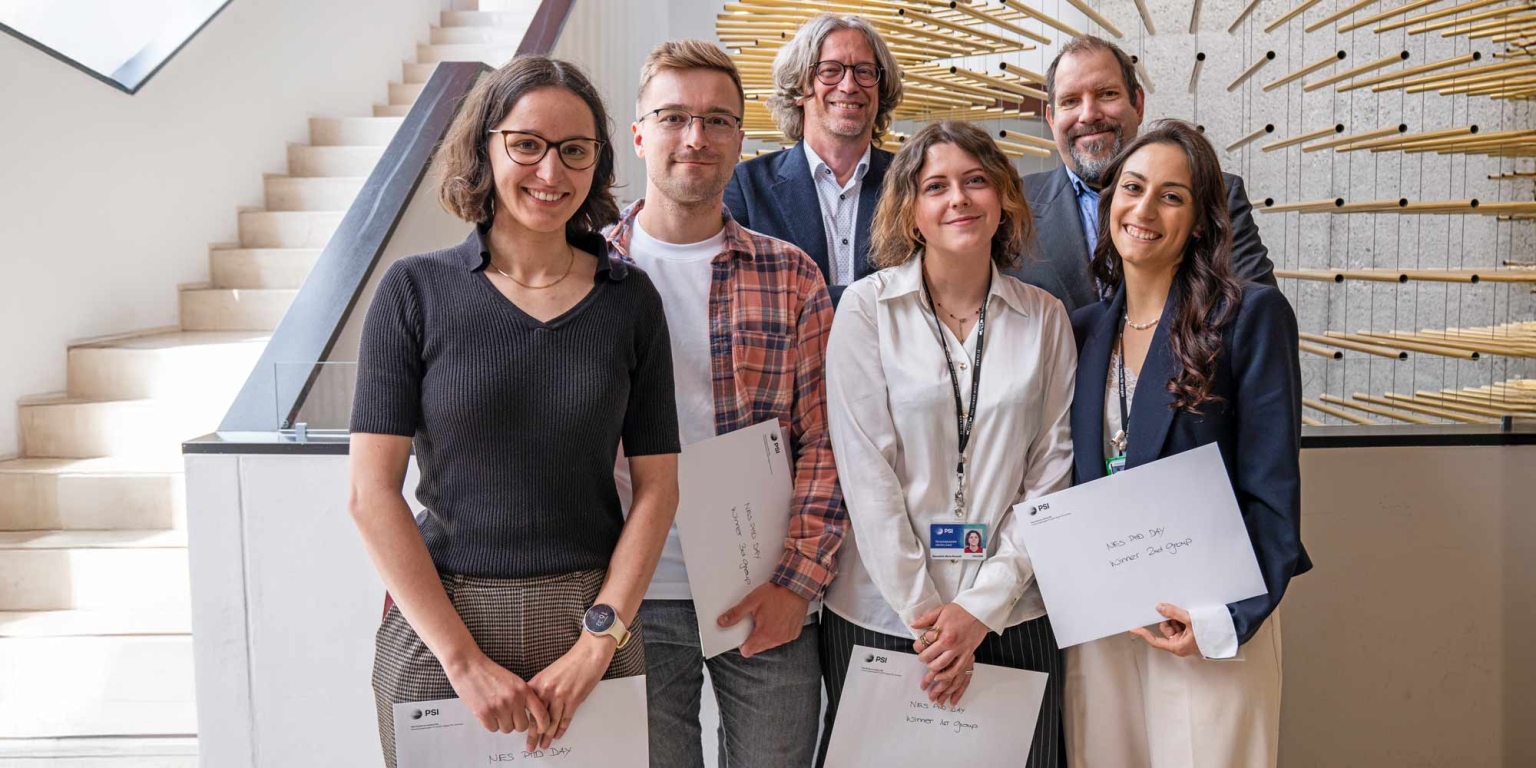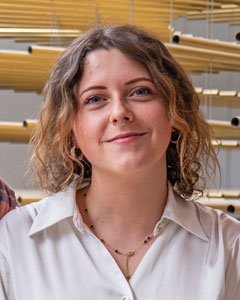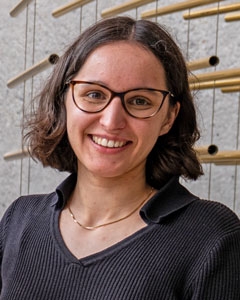Doktorandentag 2025 des Center for Nuclear Engineering and Sciences am PSI
Das Center for Nuclear Engineering and Sciences (NES) am Paul Scherrer Institut (PSI) hat auch 2025 seinen Doktorandentag durchgeführt. 33 Doktorandinnen und Doktoranden haben ihre Forschungsarbeiten einer Jury vorgestellt. Die vier besten Präsentationen wurden mit Preisen ausgezeichnet, die das Nuklearforum Schweiz sponserte.

Am Vormittag stellten die 33 Doktorandinnen und Doktoranden aufgeteilt in vier Gruppen ihre Arbeiten als Poster der Fachjury vor. Die jeweils zwei besten Teilnehmenden jeder Gruppe stellten ihre Arbeiten dann nochmals in Kurzvorträgen am Nachmittag dem versammelten Publikum sowie der Jury vor. Die beste Präsentation jeder Gruppe wurde mit einem Preis von CHF 750 ausgezeichnet, den das Nuklearforum Schweiz sponsert
Das Nuklearforum Schweiz und die Jury unter der Leitung von Professor Andreas Pautz (Leiter NES) gratulieren den Gewinnerinnen und Gewinnern herzlich für ihre ausgezeichneten Arbeiten und Präsentationen.
Die Preisträgerinnen und der Preisträger

Benedetta Buzzatti
Erste Gruppe, Laboratory for Nuclear Materials (LNM) des PSICreep properties assessment of outer liner cladding under intermediate dry storage conditions
Spent fuel rods in intermediate dry storage are subjected to internal pressure and temperature due to fission products and decay heat. These conditions cause cladding creep, which could potentially lead to failure. Additionally, the hydrogen taken up into the cladding due to waterside corrosion during the reactor operation affects the thermo-mechanical properties of the cladding, further impacting its creep behavior.
A Zircaloy-4-based outer liner cladding, known as duplex cladding (DX D4), consists of two distinct Zr-alloys with slightly different alloying compositions: an inner substrate and a thin outer liner designed to enhance corrosion resistance. They exhibit different terminal solid solubilities for hydrogen precipitation (TSSp) and, thus, different precipitation kinetics during cooling.
This PhD project aims to investigate the creep properties of outer liner zirconium cladding under dry-storage conditions. In the first year, several experimental techniques for studying creep will be screened to identify the most suitable approach for non-irradiated and irradiated cladding material.
The first phase of this study involves uniaxial tensile tests using dog-bone samples of liner and substrate material, both with and without hydrogen. Figure 1 shows a dog-bone sample produced from TREX material, a thicker pre-product for liner cladding whose thermal-mechanical treatments differ from the final cladding.
The samples were produced via Electrical Discharge Machining (EDM), isolating the outer liner material from the inner substrate. The use of TREX material and this technique ensure a precise separation of the two materials for the mechanical characterisation, which is not possible with the final cladding due to its very thin liner.
These test results will provide insight into the mechanical properties of the TREX liner and substrate parts, particularly under hydrogen influence, and deliver indications for the parameters of the creep experiments. Future goals include evaluating the differences in the creep behavior of TREX liner and substrate, DX D4 and Zircaloy-4 claddings. To determine creep laws for DX D4 and Zircaloy-4, tests on C-shape sample in combination with FEM, with input of the prior mechanical tests, will be performed. A final objective is to perform tests on irradiated DX D4 cladding for which creep properties cannot be found in the open literature and which are of high interest for the industry.

Antonella Mele
Zweite Gruppe, Department Radiation Safety and Security (ASI) des PSI sowie School of Engineering der EPFLAdvanced Modelling of PADC Detector for Accurate Neutron Dosimetry
Neutron dosimetry is a critical aspect of radiation protection across various sectors, including nuclear energy production, medical applications, and high-energy physics research. However, accurate measurements of neutrons dose remain challenging due to neutrons' extreme energy variability, spanning over ten orders of magnitude and affecting both reaction types and interaction cross-sections. Likewise, fluence-to-dose conversion factors can vary by an order of magnitude with neutron energy.
This project aims to develop a predictive model for PADC detectors to accurately forecast their response. By integrating a Monte Carlo simulation of the detector's irradiation conditions with an analytical model for the track formation and evolution, the objective is to predict the detector’s efficiency for any neutron spectrum and irradiation geometry.
The model is currently being developed and will be validated under reference conditions through simulations and experiment using well-characterized neutron sources such as 241AmBe and 252Cf. Future developments will focus on expanding the model to cover a broader range of neutron energies and incident angles, as well as further testing in realistic neutron workplace fields.
Our aim is to improve the energy response and efficiency of one of the most widely used personal neutron dosimeter while enabling the prediction of its response in complex or poorly characterized neutron fields using computational methods. This is particularly important in environments such as nuclear reactors or high energy accelerators where the neutron field strongly vary with respect to calibration sources, leading to greater uncertainty and imprecision in the measurements.

Vladislav Zobnin
Dritte Gruppe, Laboratory of Radiochemistry (LRC) des PSIThermosublimatography of Tellurium dissolved in LBE: Transport Mechanisms and Moisture Effects
Lead-Bismuth Eutectic (LBE) is a promising coolant for the next generation lead-alloy cooled fast reactors because of its favorable thermophysical properties. Safety assessments for these reactors require understanding the volatilization behavior of radioactive impurities such as Tellurium (Te) dissolved in the liquid metal. Our research investigates transport mechanisms of Te released from LBE using thermosublimatography.
Experiments were conducted using LBE doped with activated Te (xTe = 0.001). Quartz glass and stainless-steel columns were used for the thermosublimatography experiments. Carrier gases included dry He, humidified He, and He with 10% vol. H2. Gamma spectrometry and SEM/EDX analysis methods were used.
Results revealed two distinct depositions when tellurium is evaporated from LBE in quartz glass columns: a high-temperature deposition (~500°C) identified as PbTe, and a low-temperature deposition (~200°C) identified as crystalline Te. The formation of the low-temperature deposition is attributed to PbTe decomposition producing a volatile fraction. Humidity significantly influenced this decomposition process, with higher humidity leading to almost complete PbTe decomposition. This process was inhibited in reducing atmospheres.
Steel columns exhibited different behavior, showing only high-temperature PbTe deposition with no low-temperature deposition.
Our findings demonstrate that Te primarily evaporates as PbTe from LBE, which can be interpreted as retention, since PbTe is less volatile than elemental Te.

Noemi Cerboni
Vierte Gruppe, Laboratory of Radiochemistry (LRC) des PSIEnhancing Target Stability for Superheavy Element Production via Coupled Reduction
The production of superheavy elements requires robust targets that can withstand intense heavy ion beams while efficiently dissipating heat and charge. Due to the scarcity of heavy actinides, molecular plating (MP) is widely used for target fabrication due to the achievable high deposition yields. However, layers deposited by MP lack thermal and electrical conductivity, making them prone to damage during irradiation. To address this, I. Usoltsev et al. introduced coupled reduction (CR) – a high-temperature treatment (840 – 1100 °C) under a hydrogen atmosphere following MP – to enhance target stability. First tests under typical irradiation conditions at the Joint Institute of Nuclear Research in Dubna, Russia, have shown promising results.
This thesis aims to further understand the underlying mechanism of CR reaction and to develop thin, conductive, and robust targets for future superheavy element production. As surrogates for late actinide elements, lanthanoid (Ln) thin films were first deposited onto Pd or Pt substrates via MP, followed by CR at varying treatment temperatures. Surface morphology, diffusion behavior, and phase composition were analyzed using SEM/EDX, α-spectroscopy, and XRD. The obtained results indicate that the final structure – either an intermetallic compound or a solid solution – depends on the stoichiometric ratio of Ln to Pd. Additionally, α-spectroscopy was used to investigate how the different substrate materials (i.e., Pd vs. Pt) influence the diffusion behavior of the Ln. In a next step, a multilayered thin Pd target was manufactured using various substrates, and their thermal stability was assessed by means of SEM/EDX and cross-sectional FIB analysis. Further tests are in progress to refine and optimize the approach.
The presented findings further our understanding of CR, thus contributing not only to the development of robust targets for superheavy element production but also to broader applications in related projects.
Quelle
NES des PSI und Nuklearforum Schweiz nach Doktorandentag 2025 vom 13. Mai 2025